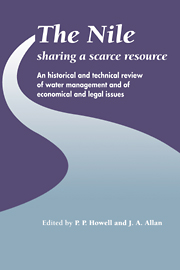 The Nile: Sharing a Scarce Resource
The Nile: Sharing a Scarce Resource Book contents
- Frontmatter
- Contents
- Preface
- List of Contributors
- Orthography
- Units and Conversion Factors
- Introduction
- I Environmental history of the Nile and its management
- 1 Origin and evolution of the Nile
- 2 History of Nile Flows
- 3 History of water use in the Sudan and Egypt
- 4 East Africa's water requirements: the Equatorial Nile Project and the Nile Waters Agreement of 1929. A brief historical review
- 5 History, hydropolitics and the Nile: Myth or reality
- II Nile management and factors affecting future management
- III Future utilisation of Nile waters
- IV Economic, international and legal issues
- Index
5 - History, hydropolitics and the Nile: Myth or reality
Published online by Cambridge University Press: 05 February 2012
- Frontmatter
- Contents
- Preface
- List of Contributors
- Orthography
- Units and Conversion Factors
- Introduction
- I Environmental history of the Nile and its management
- 1 Origin and evolution of the Nile
- 2 History of Nile Flows
- 3 History of water use in the Sudan and Egypt
- 4 East Africa's water requirements: the Equatorial Nile Project and the Nile Waters Agreement of 1929. A brief historical review
- 5 History, hydropolitics and the Nile: Myth or reality
- II Nile management and factors affecting future management
- III Future utilisation of Nile waters
- IV Economic, international and legal issues
- Index
Summary
Introduction
The dependence upon the waters of the Nile for Egypt and the Sudan led naturally to the question whence do the waters flow and thence how best to utilize them – Nile Control. In the nineteenth century Muhammad Ali began to build regulators to promote land reclamation in Egypt, but it was not until the British occupation of Egypt in 1882 that the construction of barrages and dams for flood control and irrigation to feed Egypt's rapidly expanding population was systematically undertaken. During the political domination of Lord Cromer at Cairo and the sweeping conception of the hydrological unity of the Nile Basin by his hydrological adviser, Sir William Garstin, Nile Control from its sources to the Mediterranean became a reality seriously contemplated by the corps of British and later Egyptian hydrologists and engineers who embarked upon the research required to develop the Nile Basin for the full utilization of its waters, particularly after the inclusion of the Sudan and East Africa within the British imperium, combined with British diplomatic domination at Addis Ababa.
Garstin was the first to envisage the hydrological development of the Nile Basin in 1904, but his majesterial report was followed by the refinements of Sir Murdoch MacDonald in Nile Control (1921). After a lacuna during the interwar years, the famous proposal for the full utilization of the Nile waters by H.E. Hurst in The Future Conservation of the Nile (1946), and the later brilliant mathematical model by H.A.W. Morrice and W.N. Allan in the Report on the Nile Valley Plan (1958), was the most efficient design for Nile Control conceived.
- Type
- Chapter
- Information
- The Nile: Sharing a Scarce ResourceA Historical and Technical Review of Water Management and of Economical and Legal Issues, pp. 109 - 136Publisher: Cambridge University PressPrint publication year: 1994
- 13
- Cited by


